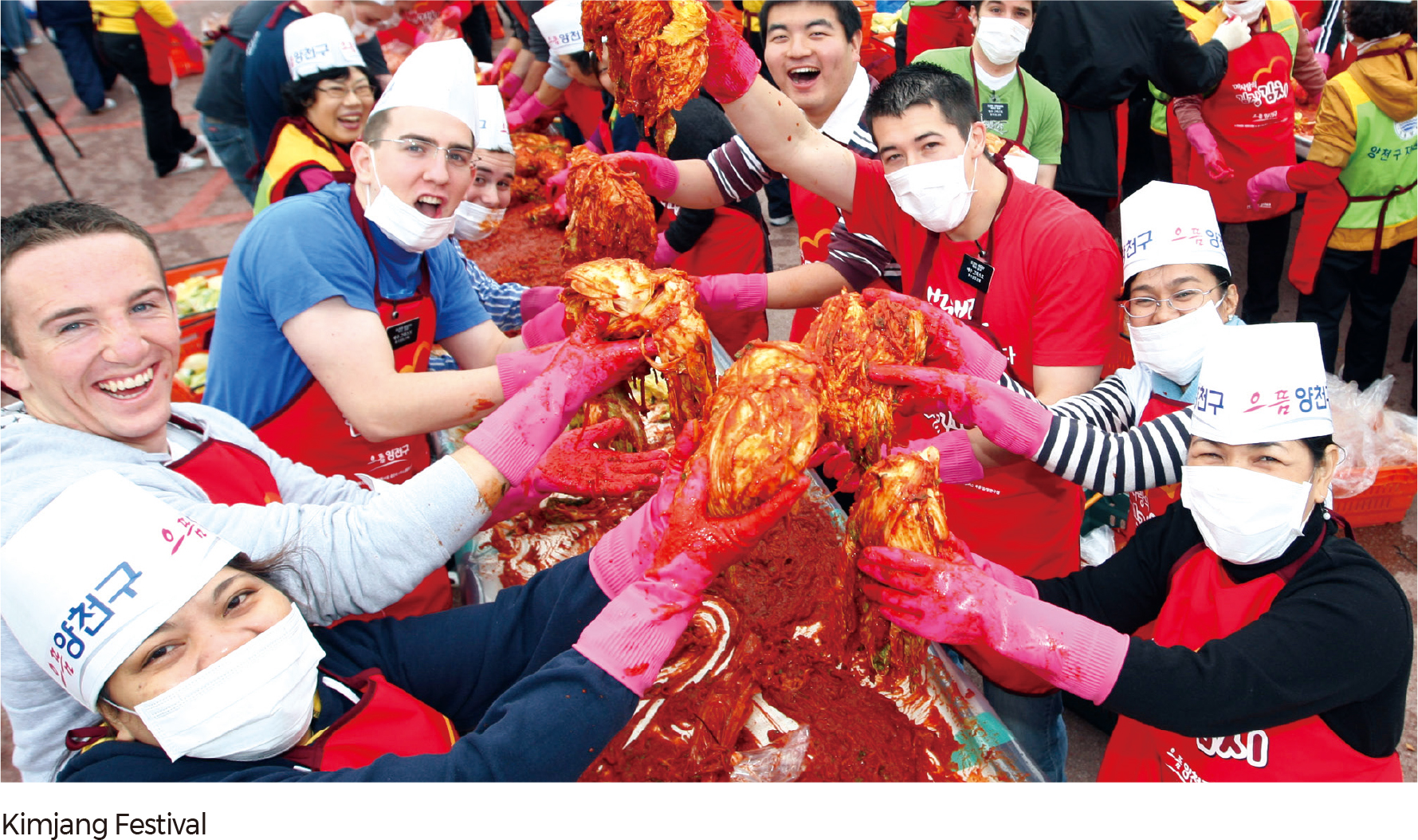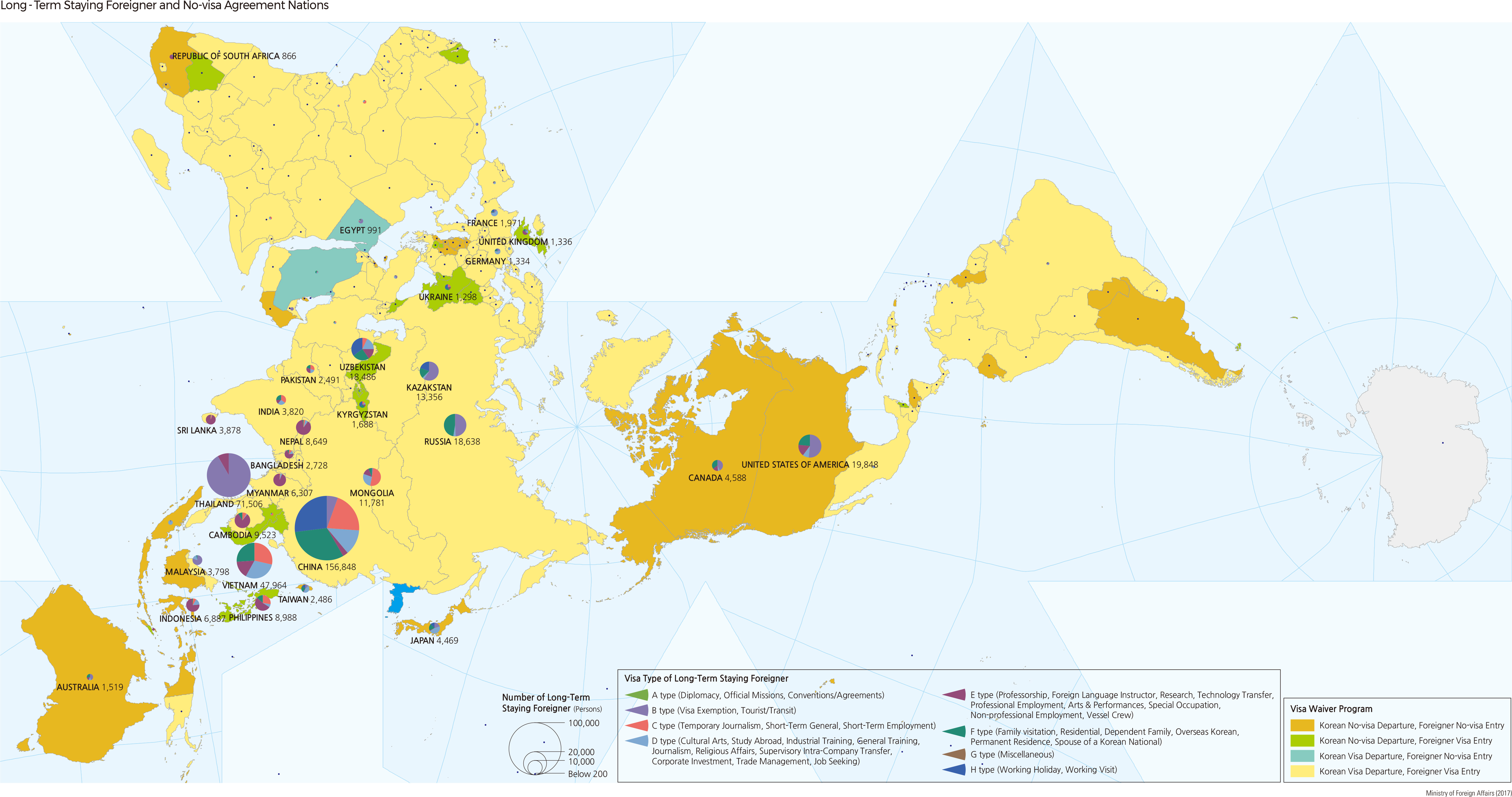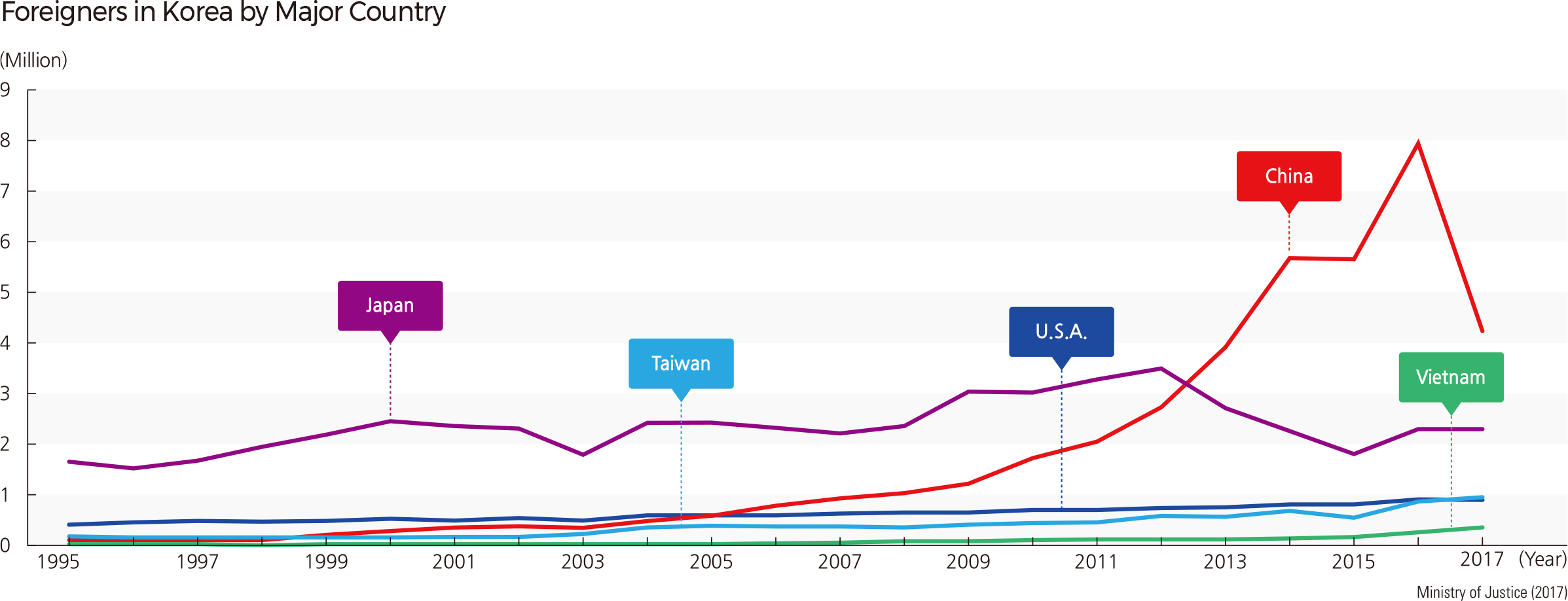English I 2019
In the era of globalization, as goods, capital, information, and technology move transnationally, so do people. In the past, only a small number of people were able to experience living abroad, but now millions of people are living and working abroad. Historically, foreigners who lived in Korea for a long time were generally diplomats, expatriates from foreign companies, US forces, and overseas Chinese. Recently, the number of foreign residents has increased sharply. Moreover, many foreign residents intend to settle down and spend the rest of their lives in Korea, changing Korean society to a multicultural society.
The map shows both the number and origin of foreigners that visited Korea in 2017. About five million visitors from China, and another 2.3 million from Japan, visited Korea in 2017. Taiwanese and American visitors were about 0.9 million each. The number of visitors from the other countries was less than 0.5 million. More visitors are currently coming to Korea from geographically close countries, and the number of visitors decreases as distance increases. An exception to this pattern is the United States, with which Korea has kept a close relationship since the Cold War era.
The graph shows the trends of Koreans who go abroad and foreigners who visit Korea. Until 1960, both numbers were less than 10,000. The number of foreign visitors reached 100,000 in 1970, 1 million in 1983, 5 million in 2005, and 10 million in 2012. In 2018, approximately 15.6 million people visited Korea. For a long time, foreign arrivals exceeded Korean departures. Until 1988, the number of foreign arrivals was double the number of Korean departures. This trend was reversed in 1989 after the Korean government authorized more overseas travel. Since then, Korean departures have gradually increased, except during the economic recessions in the late 1990s and the late 2000s. In 2018, the number of Koreans who traveled abroad was approximately 29 million, which is twice the number of foreign visitors.
The pie charts show that most Koreans exit the country through Incheon International Airport, but Gimhae Airport, Gimpo International Airport, and Busan Port are used as well. Most foreigners arrive in Korea via the ports in the Seoul Metropolitan Areas, such as Incheon International Airport and Gimpo International Airport. Others rely upon airports in Gimhae, Jeju, and Busan Port.
On the 2017 map depicting the departure of Koreans and the entry of foreigners, we can see increased personal exchanges across the national boundary. As of late 2017, the Korean government had signed visa-free exemption agreements with 106 countries around the world to facilitate personal exchange. Sixty-nine countries have signed agreements to exempt general passport holders from visas. Also, the Korean government has promoted these personal exchanges through visa waiver programs with many countries. Koreans are free to travel to 59 countries without a visa, while foreigners from 48 countries may enter Korea without a visa, even though there may be special regulations in some countries.
The map also shows the foreigners who take extended stays, where they are from, and why they have come to Korea. We can find the purpose of their stays through their visas, which are classified into eight types: A type (Diplomacy, Official Missions, Conventions/Agreements), B type (Visa Exemption, Tourist/Transit), C type (Temporary Journalism, Short-Term General, Short-Term Employment), D type (Cultural Arts, Study Abroad, Industrial Training, General Training, Journalism, Religious Affairs, Supervisory Intra-Company Transfer, Corporate Investment, Trade Management, Job Seeking), E type (Professorship, Foreign Language Instructor, Research, Technology Transfer, Professional Employment, Arts and Performances, Special Occupation, Nonprofessional Employment, Vessel Crew), F type (Family Visit, Residential, Dependent Family, Overseas Korean, Permanent Resident, Spouse of A Korean National), G type (Miscellaneous), and H type (Working Holiday, Working Visit). The largest number of foreigners entering the country on a long-term stay visa come from China, with about 157,000 people, followed by Thailand with 72,000, Vietnam with 48,000, the United States with 20,000, Russia with 19,000, and Uzbekistan with 18,000. As of 2017, the number of foreign residents had reached 1.86 million, accounting for 3.6% of the total population. In 1990, only 65,000 people, or approximately 0.15% of the total population, were of foreign origins. Along with quantitative growth, the socio-economic characteristics of foreign migrants also changed. First, the country of origin diversified, and its composition changed. In 1990 alone, Taiwanese accounted for almost half of registered foreigners, followed by Americans and Japanese. Three countries accounted for almost 90% of foreign residents. However, now, more than half of the foreign residents are Chinese, followed by Vietnamese, Thai, American, and Filipino. The surge in Chinese, mainly composed of Korean-Chinese (Choseonjok), is a result of a Chinese government policy that encourages the dispatch of the workforce alongside economic reform. The Korean government’s policy of prioritizing the recruitment of overseas Koreans in order to mitigate the labor shortage also impacted this as Korea and China have worked together since 1992 to build and improve diplomatic relations.
There have also been significant changes in terms of migration policies. In the past, the majority of foreign migrants, except for Overseas Chinese, were diplomats, USFK, or representatives of foreign firms and their families, but since the 1990s, unskilled labor migrant workers, marriage migrants, and international students have been the main types of migrants. In particular, due to an imbalance in the male-female ratio that impacts marriage prospects for men and the demand for service personnel such as domestic childcare assistants and caregivers, many women have migrated, although fewer have than men. The large influx of overseas Koreans, mainly Korean-Chinese, and North Korean defectors is a special characteristic of Korean society, unique from other developed countries. |




